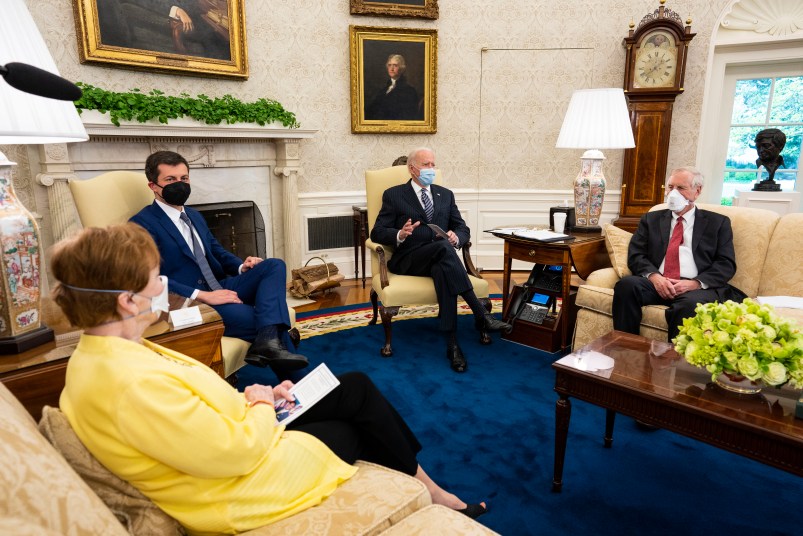Over the past two months of infrastructure talks, there’s been a constant refrain from Republican negotiators: why not just use all the unspent COVID aid money to pay for the bill?
The idea has helped negotiators avoid Biden’s demand for new spending, and has been met with some concessions, even from Democratic senators.
“You need to look at, see what hasn’t gone out the door or what has gone out the door, hasn’t been spent yet or dedicated in any way,” Sen. Joe Manchin (D-WV) said last month.
But a close look at which COVID relief funds remain “unspent” reveals that the vast majority of money available would come from President Biden’s biggest legislative accomplishment: the American Rescue Plan.
That effectively reduces the negotiations to a debate over how far the Biden administration would be willing to go to strip its signature COVID relief package, passed in March, of resources to fund entirely different priorities.
“It’s a political challenge to get anyone to repeal parts of their own bill,” Marc Goldwein, Senior Policy Director for the Committee for a Responsible Federal Budget, remarked to TPM.
A group of five Democratic and five Republican senators announced on Thursday that they had reached a deal that includes $579 billion in new spending, out of a total of $974 billion. It’s not yet clear how that would be paid for, and if that proposal would also draw on repurposed COVID funding.
Follow the money
Since infrastructure negotiations began in April, Republican senators have demanded that the Biden administration account for how the package is to be funded. Any new spending in the plan, meant to go to roads, bridges, water pipes and eldercare programs, needs to have new revenue to match it.
But at the same time, the GOP said that it would be opposed to any tax increases — framing that as changes to the Trump tax law.
What that has left as a way to finance the package is to use what Republicans refer to as “repurpose unused federal spending.”
Part of it goes to an impression that the American Rescue Plan left states and cities with too much money — confounding local officials and state legislators who lack projects to spend it on.
“The majority of it has not been spent,” said Sen. Rob Portman (R-OH) in April. “Perhaps there’s a way to spend that money on infrastructure as part of this legislation.”
Funding for states and cities in the American Rescue Plan would be uniquely vulnerable to repurposing. The money is set to come in two tranches, with the second tranche arriving one year after the first.
What that money might go to depends on the jurisdiction, but it comes as states and cities shore up budgets that were depleted during the pandemic and rehire staff that were laid off because of the virus. It also includes plans for grappling with the longer-term consequences of the pandemic, in the form of programs for those suffering from long COVID, or funding for public health programs.
It also represents a marked increase in federal investment in local government that comes after decades of neglect.
Irma Esparza Diggs, director of federal advocacy for the National League of Cities, said that for many cities, the narrative of “too much” federal aid was overblown and that officials she spoke to were still searching for more funds to restart programs that were cut during the COVID recession.
“Do I pay my mortgage? Or do I pay for my health care this month? Those are the types of decisions city leaders will have to make,” Diggs said, when asked what would happen if money was diverted away.
To Goldwein, the CRFB offical, it’s not clear if there’s even enough money left in the ARP to allow for hundreds of billions of dollars in repurposed funding.
Though there is money left in state and local funding, even that would not come anywhere near to the hundreds of billions of dollars on the table.
“There aren’t these big pots, most of the money not spent is because they haven’t figured out how to spend it yet, or there’s the child tax credit that wont go out until July,” Goldwein said.
A plan proposed by GOP negotiator Sen. Shelley Moore Capito (R-WV) last month would have seen hundreds of billions of dollars in unspent COVID money be redirected towards infrastructure.
Those negotiations faltered this week, though key portions of the GOP stance have remained: no changes to the Trump tax cuts.
Diggs’s group, along with the U.S. Conference of Mayors and the National Association of Counties, sent a letter to Senate leaders on May 27 opposing the plan.
“The funds are meant to be used to address the short term and long term effects of the economic an health care impacts of the pandemic,” she told TPM. “That this is now being floated as a pay-for is a slap in the face to local leaders who have just really struggled.”











Because, unlike you cretins, we understand the pandemic isn’t over and there will be another.
“The majority of it has not been spent,” said Sen. Rob Portman (R-PA) in April.
Correction: I believe Sen. Portman is (R - OH.)
The “unspent” COVID money will be spent soon enough.
It’s only been about 120 days since the legislation was passed, and nowhere in the bill did it say that the money was to be spent immediately if not sooner.
This is typical GQP fuckery, and It’s pretty clear that Biden will reject the whole foofaraw and do what Sen. Ron Wyden proposes—a massive infrastructure bill passed through reconciliation.
Manchin and Sinema obviously got themselves elected to the US Senate, so I can’t premise this with, ”If either of them had ANY political sense…”, but they could’ve gone either of two ways on the filibuster – and they chose the dumbass way.
If, instead of announcing a hesitance to nuke the filibuster, and putting Dems in a position of weakness, they could just have easily announced a willingness to nuke the filibuster – and put the GOP in a position of weakness.
Even if they never, ever, ever intended to carry through on that faux “willingness”, Republicans would’ve rushed pell-mell for compromise – some compromise, any compromise – to avoid being marginalized
for the next two yearspermanently.A simple majority to roll back Trump tax cuts? A simple majority to pass sweeping voting rights? A simple majority to grant statehood – and new senators – to US territories?
I may be naïve (and I often am), but I’m guessing the GOP would move toward – not away from – compromise, once they faced the existential fear of that specter. Instead, Manchin and Sinema effectively said, ”Don’t sweat it, Mitch – we’ve got your back!”
Now, of course, the question is: Why?
Even if there isn’t another wave, as the article makes clear, there are plenty of other things localities need, and are allowed, to use that money for.
Under the circumstances, the proposed ‘repurposing’ becomes a way for the reactionaries, who uniformly voted against the bill, to prevent it from achieving what it was meant to do.
Presumably, then they can blather on it about the insufficiency of federal assistance, or something worse, like, ‘what Demonrats give with one hand they take with the other.’